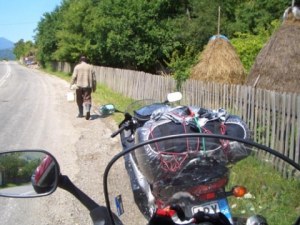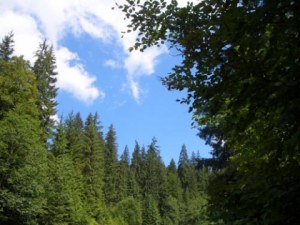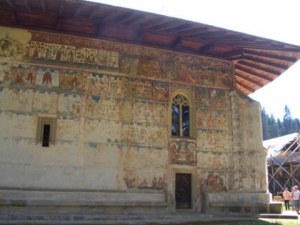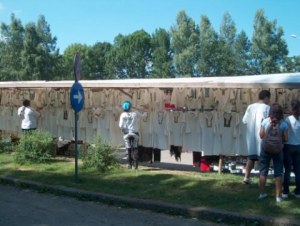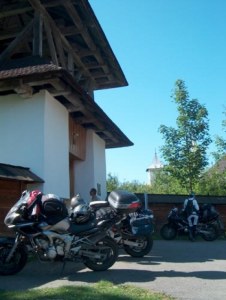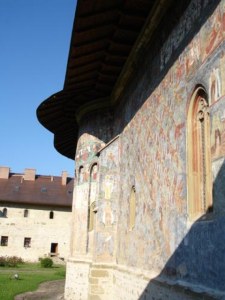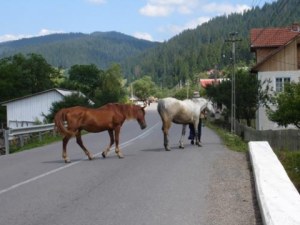The Bucovina - Suceava region is famous for its monasteries. One should visit some of the representatives, despite religions. Many monasteries constitute protected monuments of Unesco.
We left the pension around 11pm, much later than programmed. The road was following the coast of the lake up to the village with labels for Targu Neamt. From that point riding in the dense forest, on the provincial way (15B) was amazing. The negative was the situation of paving that reminded "wrinkled carpet"! I could characterize wrinkled carpets many of the roads we have ridden in Romania unfortunately. I stopped next to a source with running water in order to I fill my flask. The altitude was nearly 900m and many taverns and pensions where there to offer their services. Afterward, going down hypsometrically, we met the first plates for the monasteries: Manastirea Secu και Manastirea Neamt. Surly the most famous monasteries are Voronet, Humorului, Sucevita and Moldovita. Interesting monasteries are also those present in the region between Neamt and Piatra Neamt such as Secu, Neamt, Agapia. Our schedule included only those of Bucovina.
Reaching Targu Neamt we continued for Falticeni on the provincial network (15C), which was narrow but good. The road crosses a plain. The landscape doesn’t show any particular interest. But maybe I am not so fair, possibly because I am influenced from the previous way. Just before Falticeni we entered the national street (E850) and had a stop at the first service station for fuels. Me and Vangelis went in city (5km) in order to take out some money from a bank, while Ploumisti waited for us at the gas station. Falticeni is small town with no interest, at least from the first glance. Then we followed the provincial street (209) for 30km according to the plates for Gura Humorului. It was of very good quality but we had to pass trough every single village with a speed limit of 50km per hour while the presence of police is intense. Obviously that had to do with the increased number of accidents in the region. Just before the Gura Humorului we entered national street (E58) and moved towards the city. Following the labelling for Campulung Moldovesc, we shortly turned for Manastirea Voronet. A secondary provincial street of 4km links the monastery with the national network.
The monastery is protected by grate walls. It resembles with fortress. Outside the space was full of vendors bargaining their products. We entered in the interior paying the compensation of 4RON per person. The church, found in the centre of the courtyard-garden, is impressive. It is elongated, with the characteristic roof of the region. Its external and internal walls are covered with hagiographies. According to our guide book, most of the monasteries of the region were build by Stefan Cel Mare, a hero of Romania. Their architecture has also a role of defence. The hagiographies depict scenes of the Old Will, the Revelation, the Crisis, the life and the martyrdoms of Saints, the genealogical tree of Christ, the life of Virgin Mary, pictures of Saints, Angels, Prophets and so on… All those depictions had an educational and a teaching role for the inhabitants mainly those illiterate. Each monastery has certain particularity. In the Voronet for example a particular blue colour dominates the hagiographies. This particular nuance has taken the name of this monastery and is called "blue of Voronet ". Every monastery also has its own museum with ecclesiastical objects.
Generally in Romania in order to take photographs or videos while visiting sights you are supposed to pay around 10 to 20RON (of course in Snagov we had to pay 20 Ron!!! ...but that was only a fraud!) In some places there are guardians that supervise like in Peles but in the monasteries there is no control. Perhaps because those in charge believe in the visitor’s good will, since they claim that all income is disposed for the maintenance of the monasteries and the hagiographies. As soon as we finished our visit to Voronet, Ploumisti found the occasion to make another purchase of traditional Rumanian shirts. We left for Gura Humorului following the labelling for Monastirea Humorului. In a little while we found ourselves in front of the monastery. The themes of hagiographies were corresponding to those of Voronet with characteristic colour red. The architectural rhythm is the same apart the existence of a tower. We went up on the top via a narrow and abrupt ladder where it was hard for me to fit!!! The view from the top was amazing!
Leaving the place I asked a local whether existed a way directly for Sucevita and he answered that it was an earth-road. So we returned back to the city and followed the plates for Suceava, on national network (E576). Later we found the node for Radauti. We turned left and followed the provincial network of good quality. The landscape was beautiful. In the village Solca we took the direction for Marginea. Marginea was to be the northern point of this year's travel, some kilometres from the Ukrainian borders. Despite the fact that the street was a secondary provincial one, its quality was very good. It was a 13km straight line.
In the village Marginea we followed the provincial street (17A), one from the most beautiful routes of Romania. Certain kilometres outside Marginea we found the imposing Sucevita. At first glance it resembles more to fortress than a monastery. It dominates a totally green locality. The ticket costs 4RON per person. The architecture corresponded to the precedents. This time, the characteristic colour of hagiographies is green with red. We left Sucevita with destination Moldovita, the last monastery to visit for today, 50km far away.
The route was perhaps one of the best I have ever made. The road passes trough an impressive landscape, with big trees and amazing view and reaches the altitude of 1.100m. Words cannot describe the beauty! It was like riding in the Alpes. Along the way many locals were having "picnic". We enjoyed the ride a lot since the road’s quality was pretty good. At the higher point of the way there is monument reporting 1968 as the year of its manufacture. We arrived at Moldovita before 8mm. Visits in monasteries are allowed up to 8mm. We bought our tickets (4RON per person) and entered. The monastery’s hagiographies are characterized by a more intense yellow colour. The particularity is that it was not built by the Stefan Cel Mare, but Petru Rares.
We left searching for lodging. We finally ended up to the Pension Steaua Nordului. A tree bedroom costs 120lei. It had an amazing view. The rooms were richly decorated. We settled in with the help of the kind reception girl. At the restaurant later on we had a small surprise. Two Greeks that were working in a constructional company introduced to us. We had a little conversation. At night we moved to the veranda and we enjoyed the view of a fire that was turned on by motorcyclists - customers of hotel, as a special event... We went to bed after midnight.


